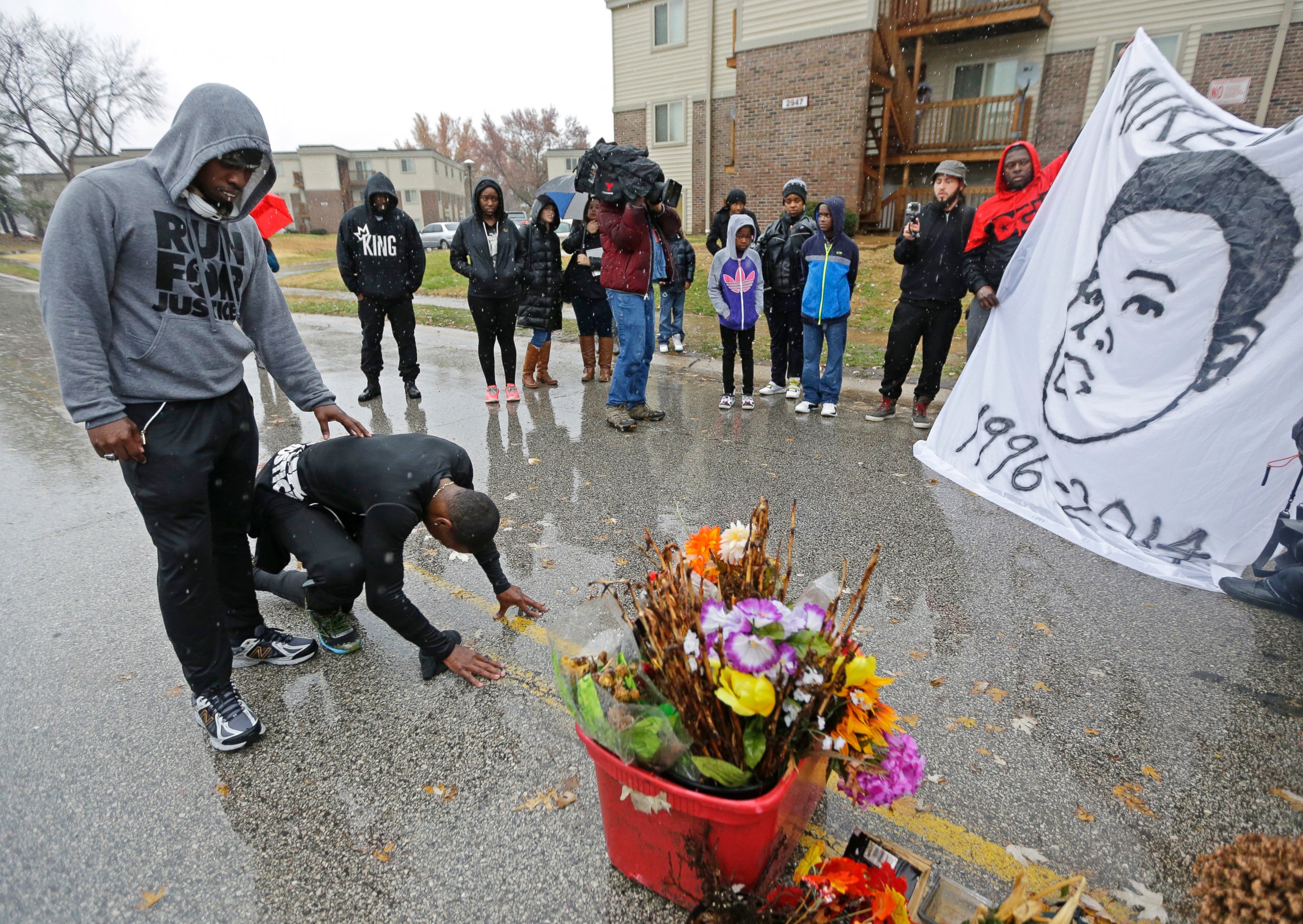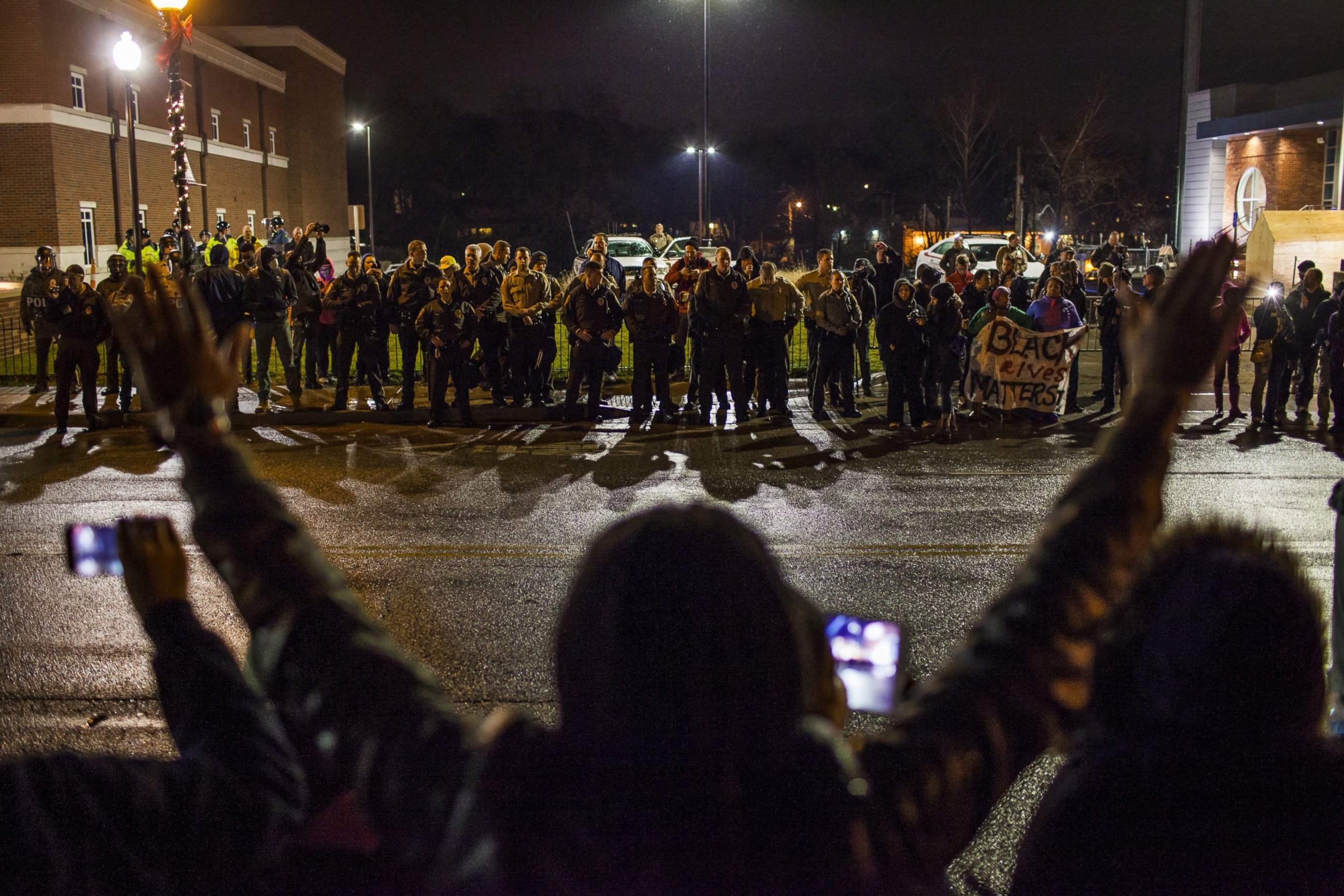What It Was Like on the Streets in Ferguson as the Grand Jury Deliberated
Missouri town at center of drama is not "on edge," but there are tense moments.
— -- A vehicle rolled up and a young black man got out. He pulled out a cell phone as he walked toward the line of stuffed animals, flowers and other memorials that have marked the site of Michael Brown's death in the street that cuts through the Canfield Green Apartments in Ferguson, Missouri, in the months since he was killed.
He looked around, shook his head and snapped a picture.
This scene plays out over and over, day after day. People drive up, park, get out, walk up, take pictures, move around, and after a while, leave. People come to see where Brown was killed, the epicenter of a story that the world has watched through their TVs, iPhones and computer screens.
Some people are moved when they get here. Some are just coming just to see in person what they've seen on those screens.
It's an experience to come here, and in turn, people want to share their experience with their friends and family.
Some visitors are here in the St. Louis suburb to protest and speak their minds.
A protester in a Tampa Bay Rays hat and black clothes spoke loudly against the killing of Brown and what he saw as a system of injustice, voicing opinions about the need for blacks to act against white oppression.
"Come on, President Obama! You ain't going to come down here and tell us we're safe!?" he said.
After his voice rang out for more than an hour, the protester meandered off the street and began talking to the small crowd of people on a part of the sidewalk next to the memorial to Brown. As he spoke, his voice grew loud again as the group debated what should be down in light of Brown's death. He turned toward me and my camera and said, "I'm gonna tell it how it is: I'm tired of being killed by middle-class, white motherf*******!"

As the protester continued speaking, a family nearby was moving out of an apartment. I walked over and asked how long they had lived there: "35 years," one of the departing residents said.
I asked another woman who lived there how she was feeling. She was quiet. "I don't want my picture taken."
I asked the first woman, a relative to the second, if she was moving out because of everything that had happened since Brown's death in front of her apartment, such as the constant presence of people like the protester.
"Yeah," she said as she looked toward the protester and back up the stairs as she prepared for another trip up to get another box. "You just can't relax around here anymore."
"He just needs to sit down," the woman who lived there said, a bit aggravated but quiet.
Her face looked tired. She had a sadness in her voice. She didn't want to look at me. I was just another invader.
When I got here in August, and when I came back this weekend, I felt tension, but also safe and calm.
That may not mesh with the feeling that people get on the outside, but that's just how it is -- at least for me.
When you only see reports from inside the main protest areas along West Florrisant or at the Ferguson Police Department, it feels like "Ferguson" -- really just those areas -- is the focus of the world.
Elsewhere in Ferguson, traffic flows. A "Season Greetings" sign stretches across the street at the police department. At the McDonald's where two journalists were infamously arrested, orders are taken and the lines flow. At the Target complex, where police had a command post, shopping goes on.
When you are actually here, the phrases "Ferguson is on edge" or "Ferguson is tense" don't exactly mesh with what you sense. It's more accurate to say small parts of Ferguson are tense at times, and even then, they flare in quick spurts.
Flash. Dissipate. Flash. Dissipate.
But as I've told residents I've talked to here, we're not here to cover the story of a calm, quiet Midwest city. We're here to cover the story of Michael Brown and Darren Wilson and the protests -- and that's what you're going to see and hear about the most.

At the Ferguson Police Department on Saturday night, one of these flash point moments occurred. Protesters started following each other into the street in front of the police and fire stations. I began to feel a palpable tension as more police came outside and formed a line behind the barricade in preparation for clearing the street.
In those moments, Ferguson -- at least one block of Ferguson -- was "on edge."
The protesters were sending a message to the police, chanting: "Whose streets!? Our streets!"
They were moving in and out of the streets, taunting police and demanding the arrest of Wilson.
In August, police moved in quickly in these situations on West Florrisant Avenue -- one of the main streets in Ferguson that saw the majority of the violence, fires and looting.
On Saturday night, police appeared calculated in their movements. As the crowd pressed against the police line in front of the fire station, a line of police in light tactical gear came out and began to flank the crowd. Some protesters noticed them and began to yell and point them out.
This was tension.
I was looking around to see where more police might come from. I was expecting a sudden surge, but it never came during that standoff.
As the night wore into the morning, certain agitators among the protesters began to push the edge by blocking vehicles with their bodies and others kept up the pressure of the physiological game.
"If you would just arrest Officer Wilson, we could all go home," a protester shouted over a megaphone. "You could get out of this cold and go back to your families. We could all go back to our families."
"We've been here since August. They're tired of us," another protester said quietly to me.
I hadn't asked him, but apparently he felt I needed to know, or perhaps he wanted to give a reminder of how long this has been playing out.
Police were surgical: Move in, make a targeted arrest and get back out. If there were sudden movements, they quickly flowed in a line and retreated the same way.
"You are unlawfully assembling. Disperse from the street or you may be arrested," an officer said over a bullhorn.
Police sounded their warning and began to inch forward and methodically get in position. Officers in light tactical gear came in front of the barricades and formed a long line down the street. It felt that any moment, police would surge forward and start making arrests, but again, after a few minutes, the protesters had moved out of the street.
"Who owns these streets? The police own this street. You're not in it anymore," a protester with a bullhorn joked aloud.
The police movements had worked: The protesters were out of the street. The protester with the bullhorn walked back across the street to rejoin the main group of protesters that had retreated. She led them on a march and the situation began to de-escalate for about five minutes.
Then there was screaming and yelling. People started running. One block down the street, police in light tactical gear had flanked behind buildings and suddenly surged forward. Everyone sprinted down to see what was happening. Police were yelling for the first time. Protesters were yelling. There was a bit of chaos. Police had arrested someone and they were escorting him up the sidewalk and back to their headquarters.
"Get on the other side of the street," a police commander yelled at me as I filmed him. I moved across the street.
I saw an officer in gear yelling at a protester, though I couldn't hear what he said. Another officer grabbed his arm and pulled him back toward the other side of the street. It reminded me of August.
Despite the escalation, the police stuck to their tactics and retreated to their building. They didn't linger. They removed themselves from the situations where, in August, they stayed and the situations sometimes grew toward violence.
The back-and-forth continued. Police moved in as a group and arrested a protester in a Guy Fawkes mask who was blocking cars in the street. But after his arrest, the protesters seemed to have had their fill for the night.
It began getting colder. It was past 12 a.m. There would be many nights to come. The numbers started to dwindle. More vehicle lights came on and they pulled away. Police began to trickle back inside and that one block of Ferguson eased into the early morning and back into being like the rest of Ferguson: calm, quiet.




